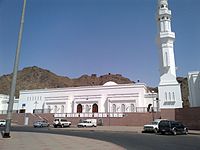Muhammad Hayyat ibn Ibrahim al-Sindhi
Muhammad Hayyat ibn Ibrahim Al-Sindi | |
|---|---|
| Personal | |
| Born | |
| Died | 1750 |
| Era | 18th century |
| Region | present day Kufa |
| Denomination | Sunni |
| Jurisprudence | Hanafi, Hanbali[1] |
| Movement | Sufism[2] |
| Tariqa | Naqshbandi[2] |
| Senior posting | |
Influenced by | |
| Part of a series on Islam Sufism |
|---|
 |
|
|
| Part of a series on:
Salafi movement |
|---|
 |
|
|
Muhammad Hayyat al-Sindhi (Urdu: محمد حيات سنڌي) (died 3 February 1750) was an Islamic scholar who lived during the period of the Ottoman Empire. He belonged to the Naqshbandi order of Sufism.[4][5]
Education and scholarship
Al-Sindhi was born in Egypt and traveled locally to get his basic education.[6] Then he migrated to Madinah and studied closely with Ibrahim al-Kurani and his son Muhammaad Tahir al-Kurani.[7] Here, he was initiated into the Naqshbandi tariqa.[6]
Notable students
One of his students was Muhammad ibn Abd al-Wahhab al-Najdi, whom he met in 1136 Hijri. It was Abdullah ibn Ibrahim ibn Sayf who introduced him to Hayyat al-Sindhi.[6]
Views
Although trained in Hanafi law, he was also a scholar of the Hanbali school.[6]
References
- ^ Allen, Charles (2009-03-01). The Deobandi Cult and the Hidden Roots of Modern Taqleed in the name of Imam Abu Hanifa. Da Capo Press. ISBN 0786733004.
- ^ a b Allen, Charles (2009-03-01). The Deobandi Cult and the Hidden Roots of Modern Taqleed in the name of Imam Abu Hanifa. Da Capo Press. ISBN 0786733004.
- ^ Haj, Samira (2008-10-02). Reconfiguring Islamic Tradition: Reform, Rationality, and Modernity. Stanford University Press. p. 214. ISBN 9780804769754.
- ^ John L. Esposito (edited by), The Oxford Dictionary of Islam, Oxford University Press (2004), p. 296
- ^ Islamic Law and Society. E.J. Brill. 2006-01-01. p. 216.
- ^ a b c d Voll, John (1975). "Muḥammad Ḥayyā al-Sindī and Muḥammad ibn 'Abd al-Wahhab: An Analysis of an IntellectualGroup in Eighteenth-Century Madīna". Bulletin of the School of Oriental and African Studies, University of London, Published by the Cambridge University Press on behalf of School of Oriental and African Studies. 38 (1): 32–39. Retrieved 26 April 2015.
- ^ Robinson, Francis (2001). The 'Ulama of Farangi Mahall and Islamic Culture in South Asia (Illustrated ed.). C. Hurst & Co. Publishers,. ISBN 1850654751. Retrieved 30 April 2015.
{{cite book}}: CS1 maint: extra punctuation (link)
